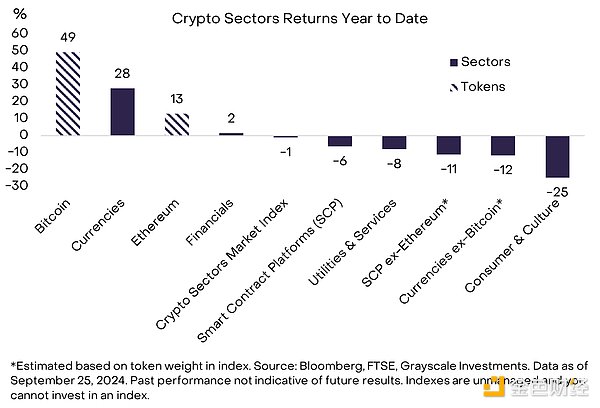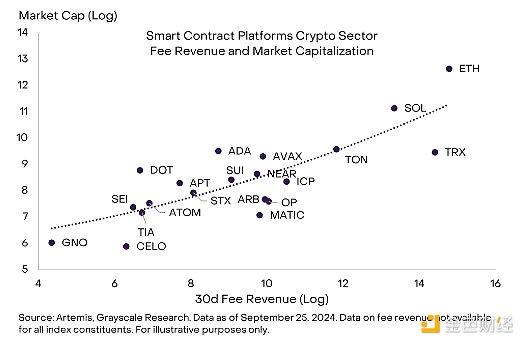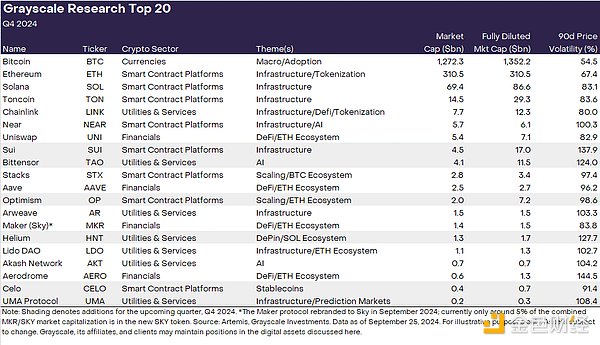Author: Grayscale Research Team; Compiler: 0xjs@黄金财经
Highlights:
The cryptocurrency market, as measured by the FTSE/Grayscale Crypto Sectors series of indices, has been trading sideways in the third quarter of 2024.
Changes in the FTSE/Grayscale series of indices this year highlight emerging themes in the digital asset industry, including the rise of decentralized artificial intelligence platforms, efforts to tokenize traditional assets, and the popularity of memecoin.
Although Ethereum has underperformed Bitcoin so far this year, it has outperformed the Smart Contract Platform Cryptocurrency Industry Index. Grayscale Research believes that Ethereum should maintain its advantage despite fierce competition in the smart contract field for a variety of reasons.
We have updated the Grayscale Research Top 20 tokens. The top 20 tokens represent diversified assets in the cryptocurrency space, which we believe have high potential in the coming quarter. New assets for Q4 include SUI, TAO, OP, HNT, CELO, and UMA.
All assets in our top 20 representative list have high price volatility and should be considered high risk; the US election may also be a significant risk event for the crypto market.
Grayscale Crypto Sectors provides a comprehensive framework for understanding the universe of investable digital assets and their relationship to the underlying technology. Based on this framework and in partnership with FTSE Russell, we developed the FTSE Grayscale Crypto Sectors Index Series to measure and monitor the crypto asset class (Figure 1). Grayscale Research incorporates the Crypto Sectors Index into its ongoing analysis of the digital asset market.
Figure 1: The Crypto Industry Index measures the performance of the asset class

The Crypto Industry Framework is designed to be updated dynamically with the evolving digital asset market and is rebalanced at the end of each quarter. The latest quarterly rebalancing process ended on September 20. Since the beginning of the year, the index rebalancing process has resulted in significant changes in the index composition, reflecting new exchange listings, changes in asset liquidity, and market performance. This year’s update to the Cryptocurrency Sector Index highlights emerging themes in the digital asset industry, including the rise of decentralized AI platforms (e.g., TAO), efforts to tokenize traditional assets (e.g., ONDO, OM, and GFI), and the popularity of memecoins (e.g., PEPE, WIF, FLOKI, and BONK).
From a returns perspective, the Bitcoin and Currencies Crypto sector has outperformed other segments in 2024 (Figure 2), likely reflecting the successful launch of spot Bitcoin exchange-traded products (ETPs) in the U.S. market and a favorable macro backdrop for the asset (see our previous quarterly report “Grayscale Research Insights: 2024Q3 Cryptocurrency Sector” for more details).
Figure 2: Bitcoin has outperformed this year, while Ethereum has performed well

Ethereum is up 13% year to date as of September 25, less than Bitcoin, but outperforming most other crypto assets. For example, our Crypto Sector Market Index (CSMI), which measures returns across the entire asset class, is down about 1% this year. In fact, excluding Ethereum, the Smart Contract Platform Crypto Sector Index is down about 11%, so it has significantly outperformed its market segments. Ethereum has delivered roughly the 70th-75th percentile of year-to-date returns across all assets in our crypto industry framework. So while Ethereum has appreciated less than Bitcoin, it has still performed well this year compared to the crypto industry and the broader CSMI.
Smart Contract Platform Spotlight
Unlike Bitcoin, which dominates the currency cryptocurrency space, Ethereum faces stiff competition in the smart contract platform cryptocurrency space. This year, many smart contract alternative platforms have gained traction, including Solana, Toncoin, Tron, and Near, as well as new entrants to the crypto space like Sui. These assets are all competing for fee revenue, and the compelling user experience offered by some smart contract alternative platforms could lead to a decline in Ethereum’s Layer 1 fee market share.
At the same time, Ethereum has several comparative advantages that support its position in the smart contract platform cryptocurrency space (Figure 3). Most importantly, it remains the leader in the category, with the most applications, the most developers, the highest 30-day fee revenue, and the most value locked in smart contracts. When the largest Ethereum layer 2 network is included, it is second only to Solana in terms of daily active users.
Figure 3: Ethereum is the leader in the smart contract platform fee revenue category

As public blockchain technology continues to be adopted, Grayscale Research expects the entire smart contract platform crypto space to grow (in terms of users, transactions, and fees), which could benefit all assets in the category to some extent. Since Ethereum is the leader in the category, it is difficult to imagine a period of continued growth in the smart contract platform space that would not benefit Ethereum, in part due to Ethereum's existing network effects. Therefore, despite the stiff competition Ethereum faces, we believe Ethereum remains a compelling asset in the smart contract platform crypto space.
In addition, Ethereum benefits from certain specific features that may temporarily deter its competitors. These features include high network reliability (limited outages), high economic security, high decentralization, and clearer regulatory status in the United States. There are also encouraging adoption trends emerging in the Ethereum ecosystem, including tokenization, prediction markets, and building by major companies such as Sony. For all of these reasons, Grayscale Research continues to believe Ethereum is a very compelling investment theme.
Grayscale Research Top 20 Tokens
Every quarter, the Grayscale Research team analyzes hundreds of digital assets to inform the rebalancing process of the FTSE/Grayscale Crypto Sector Index Series. After this process, Grayscale Research lists the top 20 assets in the cryptocurrency industry. The top 20 assets represent a diverse range of assets in the cryptocurrency industry that we believe have high potential in the coming quarter (Exhibit 4). Our approach combines a range of factors, including network growth/adoption, upcoming catalysts, sustainability of fundamentals, token valuations, token supply inflation, and potential tail risks.
Q4 We included 6 new assets in the Top 20 tokens:
1. Sui:A high-performance layer 1 smart contract blockchain that provides innovative applications.
2. Bittensor:A platform that promotes the development of open and global artificial intelligence systems.
3. Optimism:An Ethereum scaling project based on optimistic Rollup (a scaling solution).
4. Helium:A decentralized wireless network running on Solana, a leader in the decentralized physical infrastructure (DePin) category.
5. Celo:A mobile-first blockchain project that is transitioning to the Ethereum 2-layer network, focusing on stablecoins and payments.
6. UMA Protocol:An optimistic oracle network that provides services for the leading blockchain-based prediction market Polymarket (and other protocols).
Figure 4: High-potential assets in the cryptocurrency space in Q4 2024

The newly included assets reflect several crypto market themes that Grayscale Research focuses on.
Both Sui and Optimism can be considered examples of high-performance infrastructure.
Sui is a third-generation blockchain developed by a team of former Meta engineers. Two months ago, Sui underwent a network upgrade that increased transaction speeds by 80%, surpassing Solana; this has led to a recent increase in the network's adoption rate.
Optimism is an Ethereum layer 2 that is helping to scale the Ethereum network and has developed a framework for building scaling solutions, called “Hyperchains,” which is being used by Coinbase’s layer 2 BASE and the layer 2 built by Sam Altman’s Worldcoin.
Both Celo and UMA are benefiting from unique adoption trends: stablecoin usage and prediction markets.
Celo is a blockchain focused on stablecoins and payments in the developing world that has gained traction in Africa, led primarily by the Opera browser’s MiniPay app. Celo recently surpassed Tron as the largest blockchain in stablecoin usage by daily addresses and is currently migrating from a standalone blockchain to Ethereum’s layer 2 in Optimism’s Hyperchain framework.
UMA is the oracle network used by Polymarket, the crypto election year breakthrough app. UMA records the resolution of each Polymarket event contract outcome on-chain and facilitates voting on Polymarket outcome disputes, ensuring that resolution is not interfered with by centralization, arbitrariness, or bias.
Helium’s inclusion reflects our preference for category leaders and projects with sustainable revenue. Helium is a leader in the DePIN (Decentralized Physical Infrastructure Network) category, leveraging a decentralized model to efficiently allocate resources for wireless network coverage and connectivity and reward participants who maintain network infrastructure. Helium has scaled to over 1 million hotspots and 100,000 mobile users, generating over $2 million in network fee revenue so far this year.
Finally, while we have been focused on the topic of decentralized AI for some time, Bittensor has only now entered our cryptocurrency industry framework due to improvements in market structure (particularly more available pricing sources and higher liquidity). Bittensor has become a prominent player at the intersection of Crypto and AI, attracting a lot of attention for its attempt to use economic incentives to create a global decentralized platform for AI innovation.
This quarter, we replaced the following projects from our top 20: Render, Mantle, ThorChain, Pendle, Illuvium, and Raydium. Grayscale Research continues to see value in these projects, and they remain important components of the crypto ecosystem. However, we believe the revised top 20 list could result in more attractive risk-adjusted returns for the next quarter.
Investing in the crypto asset class involves risks, some of which are unique to the crypto asset class, including smart contract vulnerabilities and regulatory uncertainty. In addition, all of the assets in our top 20 are highly volatile, should be considered high risk, and are not suitable for all investors.
Finally, broader macroeconomic and financial market developments could impact crypto asset valuations, and the U.S. election in November should be considered a significant risk event for crypto markets. Former President Trump has clearly embraced the digital asset industry, and Vice President Harris recently stated that her administration “will encourage innovative technologies like artificial intelligence and digital assets while protecting our consumers and investors.” Given the risks associated with this asset class, any investment in digital assets should be considered in the context of a portfolio and with consideration of an investor’s financial goals.
 JinseFinance
JinseFinance
 JinseFinance
JinseFinance JinseFinance
JinseFinance JinseFinance
JinseFinance JinseFinance
JinseFinance Catherine
Catherine Beincrypto
Beincrypto Beincrypto
Beincrypto Bitcoinist
Bitcoinist Bitcoinist
Bitcoinist Nulltx
Nulltx